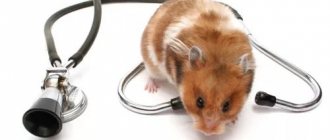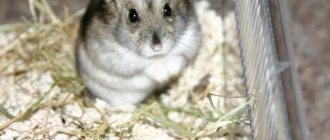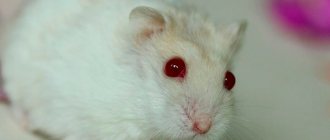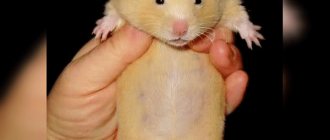Causes of hamster death
The death of a tiny creature can be provoked by various factors, so first of all you need to understand why hamsters die. Here are the most common reasons:
- Old age. The biological clock of small rodents runs very quickly. Their life is short even when kept in optimal conditions. The animal's heart and blood vessels wear out very quickly, as a result the animal dies before reaching 3 years of age.
- Unhealthy food. Hamsters are omnivores, they will willingly eat everything you offer them. But not all food is good for a rodent, so responsibility for the proper nutrition of the animal lies with the owners. Most human foods are harmful to a hamster. Spicy and sour foods corrode the walls of the digestive tract, resulting in ulcers from which the furry friend will die long and painfully. Some foods cause severe diarrhea; due to dehydration, the fluffy can die within two days.
- Hypothermia. Djungarian hamsters and representatives of the Syrian breed need to maintain a special temperature regime. Optimal air temperature values are 22±2ºС. A prolonged drop in temperature provokes colds. Hamsters often die from hypothermia after water treatments if the owners are too lazy to dry the animal’s fur. Drafts can also kill a fluffy.
- Diseases. The deadliest diseases in rodents are cancers. Hamsters also suffer from viral and bacterial infections. If your dzhungarik died, then diabetes mellitus may well be the cause. Intracavitary parasites also deal a crushing blow to the health of a tiny creature. If a homa falls from a height, he may receive injuries that are incompatible with life.
- Stress. A stressful situation can be caused by a number of factors. This includes unsanitary conditions in the cage, monotonous food, and the presence of cats and dogs at home. Violation of the daily routine also makes the animal nervous.
- Difficult birth. If a hamster gives birth before 4 months of age, she may die. There is also a risk of death if there are too many cubs.
If the hamster suddenly died, there could be any reasons. But when a homa has been living with you for 3 years, becoming more lethargic day by day, he dies of old age. Let's consider this issue in more detail.
What can a hamster die from?
A variety of reasons can lead to the death of hamsters, ranging from accidents while walking or poor diet to severe cancer.
Poor nutrition
This reason is perhaps the most common of those that lead to the death of any animals kept in captivity.
Most often, this begins to happen after the owner of the small animal treats it with some inappropriate food.
To avoid health problems associated with an incorrect menu, you should first study the lists of permitted (and even necessary) and prohibited foods for a hamster.
You can also purchase ready-made food for rodents in pet stores, then your pet will be provided with the necessary complex of nutrients.
Violation of content rules
The size of the cage and the material from which it is made, the availability of food and clean water, the possibility of grinding teeth, regular sanitary and hygiene measures - all this is of great importance for the life and health of the hamster.
If you forget to fill the feeders and drinkers on time and clean the tray, you can significantly shorten the life of a small pet.
It is also possible that the owners are very attentive to the issue of caring for their pet, but do not know some important rule. For example, they do not understand that a hamster cannot be kept in an area that is too limited in size; it is undesirable to place two males in one cage, as well as a male and pregnant or recently given birth females.
Very often, owners, especially children, forget that hamsters should not be disturbed while sleeping.
Drafts and stuffiness
Hamsters react very gently to any change in weather and temperature conditions, which is why they should never be placed near windows and doorways. The comfortable temperature for the normal life of these animals is +15. +20 °C.
In addition, excess sunlight can not only lead to overheating and subsequent death of the animal, but also ruin its daily routine, which also negatively affects health.
Pregnancy and childbirth
Pregnancy itself is very rarely a process that leads to death, but during childbirth, hamsters die much more often. But during pregnancy they are very susceptible to a variety of infectious and viral diseases, influenza, and various concomitant gynecological diseases, which often cause the death of females.
Childbirth can be complicated as a result of an inappropriate degree of development of the female’s reproductive system, the too large size of her cubs, various complications in the form of bleeding, ruptures, fractures of the pelvic bones, etc.
In order to avoid the possible death of pets as a result of pregnancy and childbirth, it is recommended to first select the healthiest and strongest potential parents for the breeding process. The age of all hamsters entering the reproductive period is quite low and is only 1–1.5 months for a female and 2–3 months for a male.
To increase the likelihood of successful completion of the breeding process, experienced hamster breeders recommend using only females over 4 months of age and males over 6 months of age for breeding.
Stroke, heart attack
The frequency of development of these pathologies in hamsters directly depends on their diet, age and vital activity.
The likelihood of these dangerous conditions occurring is negatively affected by the pet’s advanced age, decreased vital activity, as well as a diet rich in a large variety of fats, incl. cholesterol. Controlling cholesterol levels is especially important, since it affects the degree of development of atherosclerosis in the vessels, which is the cause of such conditions.
Sometimes, as a result of a stroke, a hamster can be paralyzed and will live in a cage for a long time with immobilized front or hind limbs. As for heart attacks, the likelihood of successfully surviving them is extremely low, but sometimes this happens.
Caring for an animal that has suffered one of these conditions must be as thorough as possible; it must be given as much attention as possible and try to brighten up the remaining short period of its life.
Diseases and injuries
This group includes a variety of bacterial infections, viral infections, parasitic infestations, metabolic diseases, dysfunction of the endocrine, nervous, digestive, respiratory and other systems, various oncological diseases, as well as fractures, paralysis, cuts, skeletal injuries, deaths due to falls and more many other reasons.
It is almost impossible to effectively resist such a variety of such varied causes, so the best option for preventing them is to carefully monitor the current state of your pet’s health, adequately respond to the slightest signs of the appearance of any pathology, and prevent the occurrence of various potentially traumatic situations for the animal.
Death from old age
The main cause of death in older animals (and not only hamsters) is wear and tear of the heart muscle and blood vessels. For example, in a person in a calm state, the heart beats at a frequency of approximately 70 beats per minute. In a hamster, this figure is 180 beats per minute. Just imagine how this tiny heart works!
Many factors throughout life cause stress conditions in furries, during which the heart works much faster. Thus, the heart muscle of small animals wears out very quickly, so an old hamster can die, even if all other organs are healthy.
Wear and tear of the blood vessels can result in hemorrhage into the animal’s brain, followed by paralysis. That is, Homa is still alive, but he can no longer play, run in a wheel or move at all. What to do in such a situation, put your friend to sleep or continue to care for him? This is a decision you must make yourself.
Other diseases
If your hamster is breathing frequently "out of the blue" without being scared or tired, this indicates respiratory or heart failure.
Pneumonia
You need to listen to the breathing of a tiny animal - wheezing, gurgling, snuffling indicate problems with the lungs. If you have had a runny nose lately, it could be pneumonia (pneumonia). The animal simply cannot breathe, so it tries not to move and freezes in one place.
Treatment consists of antibiotic therapy - for small rodents, Baytril 2.5% is traditionally used at a dose of 0.4 ml per 1 kg of weight (for a dzhungarik weighing 50 grams, this is 0.01 ml). Injections are given subcutaneously 1 time a day for 10-14 days.
Agony
If a hamster lies motionless with his eyes open and breathes heavily, and before that he was sick for several days, then he dies. There is no way to help a rodent in agony; even an experienced veterinarian can only end the suffering through the animal.
Consider whether there was (sign of diarrhea), sudden or severe weight loss. Hamsters have a very fast metabolism, so they cannot be sick for a long time: without proper treatment or in case of severe problems, they “burn out” in a few days.
How do hamsters die?
The death of a pet can be expected or sudden. Hamsters can die screaming or absolutely silently. Here are the signs that your hamster is dying suddenly:
- if the pet is sick, he will cry, gradually his voice will turn into a fading wheeze;
- if a pet falls from a great height, it can damage its spine, in which case its body will be limp, and death will occur within an hour;
- The paralysis of an animal can be determined by its immobility. Khoma breathes, can eat a little, but is no longer able to move independently. From now on, the hamster's days are numbered.
In the case of prolonged illnesses and old age, the following external signs will help to recognize the approaching death of the animal:
- The animal became lethargic and unsociable, although previously it was willing to be handled.
- Sudden weight loss and the animal's refusal to eat indicate that the end is near. Also, a sure sign of dying is that the homa has stopped storing food: he feels that he will not need food soon.
- The animal's eyes do not shine as before and gradually become cloudy.
- The fur takes on a dull appearance and begins to fall out or become matted.
What to do to save a dying pet
When can you save
Timely treatment will help save your pet's life. The hamster is helped by:
- for minor wounds and injuries;
- for curable diseases;
- for mild poisoning.
To do this, you first need to contact a rodent specialist.
In the case when traumatic injuries are diagnosed, the pet is provided with rest, its mobility is limited and the doctor’s orders are followed.
Wound surfaces are carefully but carefully treated with aseptic means.
In the early stages of the disease, a timely diagnosis and compliance with the doctor’s prescription will help save the rodent.
If the substance or poison that caused the poisoning is known, then you need to independently or with the help of a specialist select and give an antidote or a reverse drug. Drinking plenty of water will also help, water, chamomile decoction can be given using a syringe until the signs of poisoning disappear.
Careful care, proper feeding, keeping a dry and moderately warm room will speed up the healing process and prolong the life of the pet.
In what cases can you not help?
If the pet is old, then it is impossible to save it from natural death. The mechanisms of suppression of all vital functions associated with age will inevitably cause the death of the pet.
You also cannot help a relatively young animal:
- in case of severe poisoning, especially rat poison;
- for oncological diseases;
- with injuries incompatible with life;
- under extreme stress.
What to do when you can’t help a dying rodent
If the hamster shows no signs of life other than breathing, then you can leave it alone in its usual cage until it dies out completely.
How do hamsters behave before imminent death? When an animal groans or wheezes, it is most likely experiencing severe physical pain. In this case, you need to make a decision to euthanize your pet.
Euthanasia of a sick animal doomed to death is a choice between a painless and quick death and a slow, painful death.
Euthanasia services are provided by veterinary clinics. The procedure takes place in two main stages. First, the animal is put into deep sleep under anesthesia, after which the specialist administers a medicine that stops the heart.
At the owner's request, the rodent's body will be disposed of.
Is it possible to save a pet?
If you see that your hamster is dying, you should try to save its life. Of course, in the case of old age and cancer, it is no longer possible to help a tiny creature. The only thing you can do is prevent the animal from suffering.
But if alarming signs appear in the behavior of a young pet, you can extend its life. But at the same time, a quick consultation with a qualified specialist is a prerequisite. The sooner the doctor examines the khoma, the higher the chances of the fluffy.
Proper nutrition
There is a wide variety of food for rodents on display at pet stores. However, despite what the labels say, not all of them are created equal. Cheap food is not suitable for feeding hamsters - they are usually of poor quality, incorrectly balanced, and do not contain all the necessary substances and vitamins. There have been cases where rodent poison was found in food, which caused the death of pets.
For normal functioning, hamsters need balanced dry food. It should include cereals, plant seeds, herbs and flowers, as well as protein supplements in the form of dried insects.
It is important to give hamsters allowed vegetables and fruits. You can feed hamsters cucumber, zucchini, broccoli, cauliflower, lettuce, turnips, radish. Types of hamsters that are not predisposed to diabetes can be given pumpkin, carrots, fruits and dried fruits.
It is forbidden to give onions, white cabbage, sorrel.
We establish the fact of death
The death of a hamster can sometimes be confused with paralysis or sound sleep. If your hamster suddenly died, you need to make sure that it is really death and not paralysis. But how to do that?
The most important signs of a dead animal are the absence of a pulse and breathing. You need to bring the mirror close to the nose: if it fogs up slightly, then the animal is still alive. To determine the heartbeat, the body must be picked up. By the way, you can determine its temperature in the same way: no heat comes from dead hamsters. The fact of death may also be indicated by the numbness of the hamster.
What do Djungarian hamsters get sick of?
Small rodents have weak immunity, so they are susceptible to infectious diseases caused by viruses, bacteria and fungi. Djungarian hamsters suffer from allergies, disorders of the endocrine and digestive systems.
It is not uncommon for these animals to develop eye diseases and tumors. Small rodents often suffer from colds and pneumonia.
The main reasons for the deterioration of the health of the Djungarian hamster:
- poor diet;
- poor living conditions;
- mistakes in caring for a pet;
- stressful situations.
Mechanical injuries, bruises
A Djungarian hamster can become injured in or outside its cage. Most often, the animal suffers from the inattention of its owner when he lets the pet out for a walk on the table.
The rodent is very agile and timid, so in an instant it can run to the edge of the tabletop and fall down. Hamsters also fall from the second level of the cage or are injured while running in a wheel.
If a pet hurts itself or breaks a leg, it becomes less mobile and lethargic. Due to a strong blow to the head, disorientation and shock can occur. When a fracture occurs, the limb becomes deformed, swells, and its position looks unnatural.
If your Djungarian hamster is injured, the first thing you need to do is remove everything from the cage that could aggravate the situation:
- tunnels;
- stairs;
- hammock;
- wheel.
When a front paw is fractured, it is difficult for a hamster to remove food from its cheek pouches. Therefore, the owner should take care that the pet does not fill them too much. During illness, grain is placed in the feeder in small portions several times a day.
A Djungarian hamster needs special care if there is an open fracture of a limb. The wound should be treated with an antiseptic up to 4 times a day so that it does not fester. Otherwise, the rodent will have to be treated with antibiotics.
Cold
The Djungarian hamster is sensitive to temperature changes, dampness and drafts. Being in such conditions weakens the immune system and can cause a cold or viral disease. Due to hypothermia, small rodents often develop pneumonia.
Signs of a cold in Djungarian hamsters:
- lethargy;
- poor appetite;
- snoring;
- discharge from the nose and eyes.
The hamster is kept warm. The pet needs to receive more vitamins, so fresh vegetables and herbs are introduced into the diet. If pneumonia is suspected, antibiotics are given by injection.
Eye and dental diseases
Ophthalmic diseases in Djungarian hamsters are quite common. Their causes vary - from injuries to the organs of vision to infections that affect the eyes. The animal can injure the eyelid or the mucous membrane of the eyeball with fragments of the filler - wood shavings or dry blades of grass.
Conjunctivitis is the most common eye disease in Djungarian hamsters.
Symptoms of inflammation:
- eyelids swell and turn red;
- eyes do not open;
- purulent discharge appears from the organs of vision;
- crusts form on the fur near the eyelids;
- in bright light the animal squints.
This disease is treated with eye drops. Before each use of the solution, the eyelids are washed with a sterile swab soaked in physiological solution.
Older Djungarian hamsters have an eyesore. In this case, the lens becomes cloudy and vision disappears. This pathology cannot be treated.
Another common problem in small rodents is the development of an abscess behind the eyeball. Due to strong pressure from the inside, it bulges outward. Surgery to remove an eye will help save a sick animal.
The oral cavity is another weak point in Djungarian hamsters. Due to the constantly growing incisors, which do not have time to grind down, the mucous membrane of the cheek pouches and gums is often injured. Infection of the wound can lead to severe inflammation and an abscess.
Signs of dental disease:
- the Djungarian hamster has lost weight because it cannot eat;
- the animal rubs its muzzle with its paws;
- the fur on the neck is wet;
- The mouth doesn't close.
If the cheek pouch is inflamed, the veterinarian will clean the oral cavity of food debris, trim the incisors and tell you how to treat the inflamed area. In order for the hamster to recover faster, it is advisable not to feed it in the first 12 hours or offer only vegetable puree.
Skin diseases
Djungarian hamsters have skin diseases that are caused by fungi and parasites. These include:
- lichen;
- dermatophytosis;
- trichomoniasis.
With such diseases, the rodent experiences severe itching, bald spots, scratches, rashes, peeling, and ulcers appear on the body.
Hamsters often suffer from dermatitis. It may be caused by a food allergy. If treatment is not started on time, pathogenic bacteria will penetrate the damaged skin and an inflammatory process will begin, which will affect the deep layers of the dermis.
Depending on the diagnosis of the skin disease, they are treated with the following drugs:
- fungicidal;
- antihistamines;
- antiparasitic;
- antibiotics.
Gastrointestinal diseases
Errors in nutrition cause gastrointestinal diseases in Djungarian hamsters. Feeding with astringent foods leads to constipation, while feeding with cabbage leads to flatulence. But diarrhea is the most dangerous for your pet. Diarrhea occurs due to eating moldy grains or spoiled food.
Loose stools may be a symptom of an infectious disease. If your Djungarian hamster's tail is wet and dirty, this is a sign of diarrhea.
Important! Diarrhea cannot be ignored - it threatens severe dehydration and can lead to the death of your pet.
Digestive problems in the Djungarian hamster are indicated by lack of appetite, lethargy, and depression. The animal is showing concern. With flatulence, the volume of the abdomen increases.
If the cause of diarrhea is poisoning with low-quality products, Smecta or Enterosgel is used for treatment. Dill water helps with bloating. For constipation, the hamster is given a drop of Vaseline oil.
Tumors
A lump that suddenly appears on the body of a Djungarian hamster is most likely not a tumor, but an abscess. Purulent capsules occur when pathogenic bacteria enter damaged skin. The wound quickly heals, and inflammation begins inside. The veterinarian will open the purulent formation and tell you how to treat the incision site.
Sometimes Djungarians develop neoplasms. A benign tumor is usually not removed, since the hamster may not survive the anesthesia. If a hamster gets cancer, it is euthanized.
Preventing premature death
In order for a hamster to live a long and happy life and die only of old age, you need to take good care of it. Here are a number of rules that will help prolong the life of your pet:
- Feed the animal correctly, do not give fatty, spicy and sour foods. Remember: rodents should not eat stale food!
- Clean the cage often to reduce the chance of contracting a bacterial infection.
- Eliminate sources of stress and danger: electrical appliances, cats and dogs. Do not disturb your pet's usual routine, do not play with him forcefully.
- Do not wash the animal unless absolutely necessary and do not leave the cage with the animal in drafts.
- You cannot cross rodents too early: the hamster may die during childbirth.
- Communicate with your furry friend, he should feel your love.
- Take your fluffy to the vet periodically.
It happens that, despite all the efforts of owners and veterinarians, a pet dies. If you want to get a hamster or other animal again, thoroughly rinse the cage and all hamster furniture, and pour boiling water over it several times. This will help fight bacteria that may have caused the death of your previous pet.
Now you know why your pet may die. It should be remembered that not all hamster diseases are treatable. Therefore, preventing their development plays an important role. Timely consultations with a veterinarian, proper care of the animal, and a balanced diet will help extend its life. But if your hamster dies of old age, it is, alas, impossible to save him.
How to cope with loss
Children often grieve over a loss. In order for grief to stop tormenting them, it would be advisable to go to a pet store on the next weekend and buy a new pet there. Although in this regard the decision is made individually.
The death of a living creature is inevitable, so when taking responsibility for caring for and maintaining a hamster, remember that you will have to deal with the death of your pet. But if you kept the rodent with dignity and were an attentive owner, then these thoughts will comfort you at the moment of your pet’s death.
What to do after
After the death of a hamster, it is important to thoroughly disinfect all the accessories that were in its cage, and the cage itself too. If you are considering getting another hamster, it is important to completely kill the scent of the previous owner. It is necessary to determine the cause of the pet’s death in order to avoid fatal mistakes in the future.
If you take responsibility and get a hamster, you must provide him with comfortable living conditions. Don’t forget: your pet is just a page in your life, but you are his whole life. Take care and love your pet so that you don’t regret anything when the time comes to part ways.
Hibernation. How to identify it and not bury the hamster alive?
If the hamster died for no apparent reason, then you should not immediately grieve and go to bury it, since the rodent could simply have hibernated. This happens due to low temperatures, poor care or improper feeding. In the event of unfavorable living conditions, hamsters are able to slow down all processes of their life until better times come.
Determining hibernation is simple; for this you need:
- Touch the hamster. If he is soft and warm, then he is most likely sleeping. If the unfortunate person’s body has already become cold and numb, then the conclusion is disappointing.
- If there are serious doubts about the death of your pet, you can try to feel its heartbeat.
- You need to bring a mirror to the nose - if there are barely noticeable traces of fogging on it, then the pet is still alive.
Usually hibernation in hamsters lasts no more than a couple of days, but if the rodent does not wake up for a long time, then it will have to be considered dead.
A hamster died: reasons, signs and what to do
Hamsters have very weak bodies. Even a seemingly insignificant event for a person can become disastrous for a small pet. It is necessary to carefully monitor the health of the pet and the conditions in which it is kept in order to prevent early death.
Causes of death of hamsters
There are many reasons why hamsters can die prematurely, but among them there are several main ones, due to which small pets die most often.
Inadequate care
A hamster's cage is his home and needs regular cleaning. It is necessary to replace the cage floor bedding with a clean one and remove excrement.
In addition, hamsters constantly store food in a secluded place, where it spoils over time.
You cannot completely remove spoiled supplies, as this will cause the hamster serious stress; you need to replace its supplies with fresh food.
Dirty bedding and rotten food can cause the hamster to develop a bacterial infection, which very quickly leads to the death of the animal.
Poor nutrition
Hamsters are not picky about food; they happily eat everything their owners offer them.
But these rodents have a weak stomach and you can feed your pet only with approved foods, the list of which includes grain mixtures (sold in a pet store especially for rodents), fresh fruits and vegetables, green food, animal products (eggs, cottage cheese, boiled meat) in a small amount quantity, insects.
List of prohibited products:
- Fatty, fried, salty, sour foods.
- Spices.
- Exotic fruits.
- Sweets.
- Stale food.
- Onion garlic.
From consuming these products, a hamster can develop diarrhea, bloating, constipation and many other problems, including death.
Diseases
Hamsters are susceptible to a large number of diseases, among which infectious colds and cancer predominate. It is easier for young individuals to cope with the disease, but older hamsters more often die from one disease or another.
Hamsters often contract colds from their owners. During illness, the owner should approach the cage with the animal as little as possible and not pick it up.
Djungarian hamsters are often susceptible to diabetes.
Careless handling
Hamsters often die from heart attacks caused by extreme stress.
To avoid this, the owner must provide the pet with a comfortable existence, without harsh sounds near the cage, without disturbing the hamster’s daily routine.
Dogs and cats need to be denied access to the cage, otherwise they may frighten the rodent , which can also cause death. Noisy electrical appliances can also cause your hamster to die.
Injuries
Hamsters have very fragile bones, so they are often susceptible to various injuries, some of which lead to death. You need to pick up your pet carefully, without squeezing it tightly. During a walk, you need to carefully monitor that the rodent does not fall from a height or that something falls on it.
Sometimes a hamster can get fractures and other injuries even while in a cage.
Stuffiness and drafts
The rodent's cage should be located away from open drafts and direct sunlight. The ideal air temperature for keeping a hamster is 20-22 degrees Celsius.
From drafts, hamsters can experience colds and hypothermia, from direct sunlight - general overheating, heat and sunstroke, heart attack, stroke.
Other reasons
There are many reasons why hamsters die. Situations often occur when rodents eat something inedible and die from intestinal blockage (therefore, you should not place a plastic house in the cage); there are also frequent cases when pets gnawed wires and were electrocuted.
Common causes include difficult pregnancy and childbirth in females.
How to understand that a hamster is dying
An attentive and loving owner can understand from the behavior and appearance of his pet that something is wrong with him and take timely measures to avoid death.
How do hamsters die of old age?
Sooner or later, all pets die. It is not easy to survive the loss of an elderly hamster, but you can prepare for this sad event mentally, knowing the signs that indicate the imminent death of your pet:
- The hamster has stopped storing, eats little, and is rapidly losing weight.
- His skin became dull, became thinner, fell out in places, and his eyes became cloudy.
- The pet moves slowly, does not play, sleeps a lot, and does not run in the wheel.
Most often, hamsters die in old age due to wear and tear of the cardiovascular system. The heartbeat of rodents reaches 180 beats per minute, which causes the walls of blood vessels and the heart to wear out.
In old age, your pet needs more care and attention.
What to do if your hamster dies
If a hamster dies a natural death from old age, then it is not possible to help him.
But if the animal is young and the cause of its illness is illness or injury, then you need to consult a veterinarian as soon as possible.
At the appointment, you need to tell the doctor all the symptoms you notice and the time when it all started, so it will be easier for the veterinarian to make an accurate diagnosis.
Not always even specialists can cure a tiny hamster, but if you feel unwell, you need to show it to a doctor.
How to bury a hamster
If a hamster dies, there are several options for its burial. The first and most correct is cremation at the veterinary service.
If there is no such service in the city, then you can bury your pet in a pet cemetery. Such places are most often created by people themselves.
As a last resort, arrange a burial in the forest or on your own summer cottage.
People often bury small pets on the lawn near their house, in squares and parks. This is a bad option, since such burials are prohibited by sanitary standards. Moreover, the pet’s body can be torn up and eaten by a stray animal.
Conclusion
Not all diseases of hamsters can be treated, and even a specialized doctor is sometimes unable to save the life of a tiny creature. Therefore, some diseases are easier to prevent. Proper care, a healthy diet, a clean cage, and consultation with a veterinarian will help avoid a large number of diseases and injuries. . Unfortunately, if a hamster dies of old age, then it is impossible to help him.
Source: https://zverek.org/umer-homyak.html










